Drumfish belong to the family Sciaenidae, and the word Sciaenidae comes from the Latin word sciaena, which means “sea fish.” The Sciaenidae contains 275 species and all of them are commonly known as drum fish.
On the line, they’re fierce warriors. But according to most, they aren’t for eating, but others might disagree.
These fish are usually found in the oceans. A few species, however, can only be found in freshwater rivers and lakes. They are the most popular fish for both leisure and commercial purposes.
We’ve covered all the basics of various fresh and saltwater drum fish in this article.

Why are they called Drumfish?
Jump To
The word “drum” comes from the sound they make when communicating with their muscles. The muscle vibrates against the swimming bladder, causing a croaking sound.
It is similar to the pounding of a drum, hence the name.
The swimming bladder has a significant muscle connected to it, its most distinguishing and vital feature.
It also provides a secondary role throughout the year, such as a location call or warning for other species.
The distinct sound of each species’ “vocalization” can aid in species identification. Some species, like the California corbina, do not have this capacity.
Drumfish Appearance
The drumfish is a common ray-finned fish with a short life span. It has a long, rounded body with a groove or gap between its spine and rays and two dorsal fins that run along its back.
Drumfish, for the most part, have small mouths, jaws, and teeth. Some animals, however, have more prominent jaws and canine teeth.
While silver is the most common color, several species come in a range of hues, including red, brown, and black.
Drumfish come in various sizes, but the majority are just a few feet long and weigh up to 60 pounds. The most notable species is the 225-pounder from the Gulf of California.
Freshwater Fish are often smaller than their saltwater counterparts.
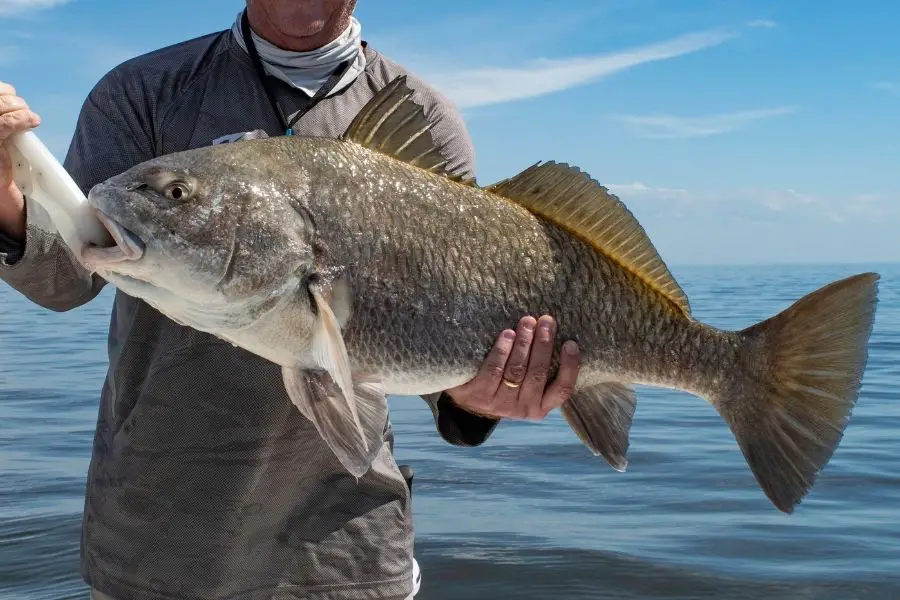
Ecology of Population of DrumFish
Only tropical and temperate saltwater areas of the Atlantic, Indian, and Pacific Oceans can get found with drumfish.
The most fantastic locations to look are along the beach, in bays and estuaries. In freshwater rivers and lakes, just a few species can survive all year.
Despite its widespread use in commercial fishing, the red drum appears to be in good ecological health.
Conservationists are not interested in the majority of species, but this is not true for all. As noted, the totuava (Totoaba macdonaldi) is currently critically endangered.
Reproduction of DrumFish and its Lifespan
Drumfish reproduction gets influenced by different variables, including the spawning season, gestation duration, and other factors.
The most typical breeding season in shallower waters is in the summer and fall.
The male uses his distinct vocalization to lure a mate. The female can lay thousands, if not millions, of eggs after copulating. After that, the male fertilizes the eggs with his sperm.
The tiny larvae emerge from the eggs after a few days and are just a few millimeters long. They achieve maturity in a matter of years.
The life expectancy of each species varies. The typical lifespan of a freshwater drum is six to thirteen years.
On the other hand, some saltwater species can live in the wild for up to 50 years. In certain cases, different extreme ages have been reported as well.
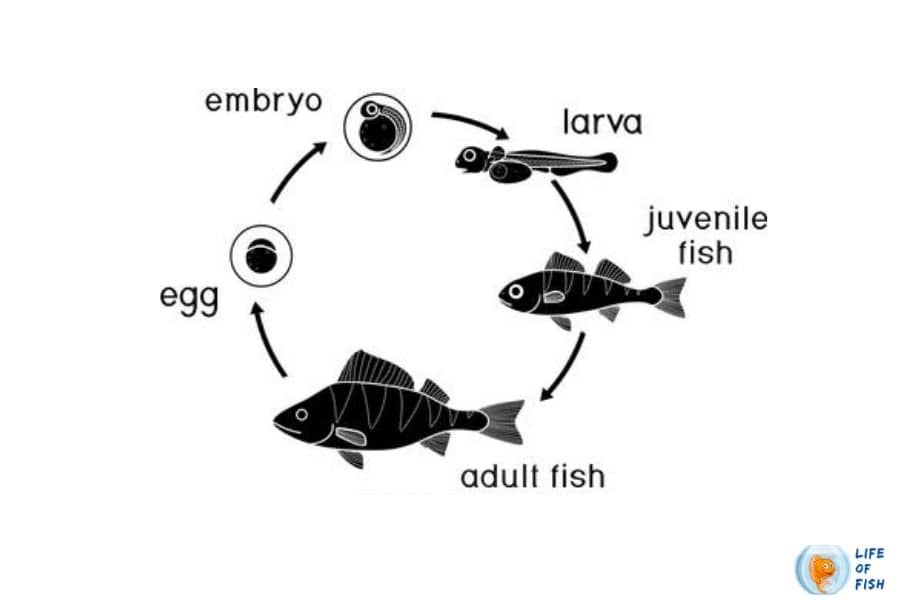
Predators and Prey of Drumfish
The drumfish is a bottom-feeding fish that eats crustaceans, mussels, insects, and other fish while swimming along the bottom of a sea, river, or lake.
Some animals have big canine teeth that can help them crush the thick shells of crabs and other shelled prey. Sea birds, humans, and Large fish are all predators of drumfish.
Overfishing, poaching, and habitat degradation due to dams and water diversion threaten the drumfish.
Types of Drumfish
The Black Drum and Red Drum are the two most common Drumfish species. The Sciaenidae family includes both of them.
Some specimens can reach 90 pounds in weight. Because they are carnivorous, these fish should not be housed with tiny fish.
They can, however, get along with non-aggressive fish of similar size. There are around 275 (and maybe as many as 300) drumfish species in the world.
We have listed some famous types below for your observation.
Red Drum: This species, commonly known as channel bass, is found only in the Atlantic Ocean between Massachusetts and Mexico. It has a black mark on the tail, despite being red and white.
Black Drum Fish: The black drum, commonly known as the drum or drummer, is a saltwater fish, in contrast to red drumfish, which can live in freshwater and saltwater.
Totuava: The totuava, also known as the totoaba, is the world’s biggest and rarest drumfish. This endangered species may be found in the Gulf of California, close to Mexico.
Freshwater Drum: The only drumfish species in North America that lives in freshwater rivers or lakes (Hudson Bay to Guatemala)
Let get into the detail of each of these drumfish types
Red DrumFish
When it’s young, redfish, technically known as Sciaenops. They can adapt to a wide range of environments, temperatures, and salinities.
A redfish of 36 inches in length may be anywhere from six to fifty years old. Redfish are eaten by ospreys and other birds, especially when they are young.
Nevertheless, humans are their biggest threat to them.
Red drum is an excellent sportfish. They’re also great for eating. Aquaculturists raise them for food in certain states.
Redfish get found in Reddish-copper coloring. The ventral side is a lighter, nearly white hue. Blunt snout Distinctive black patch towards the base of the tail The caudal fin has a little concavity.
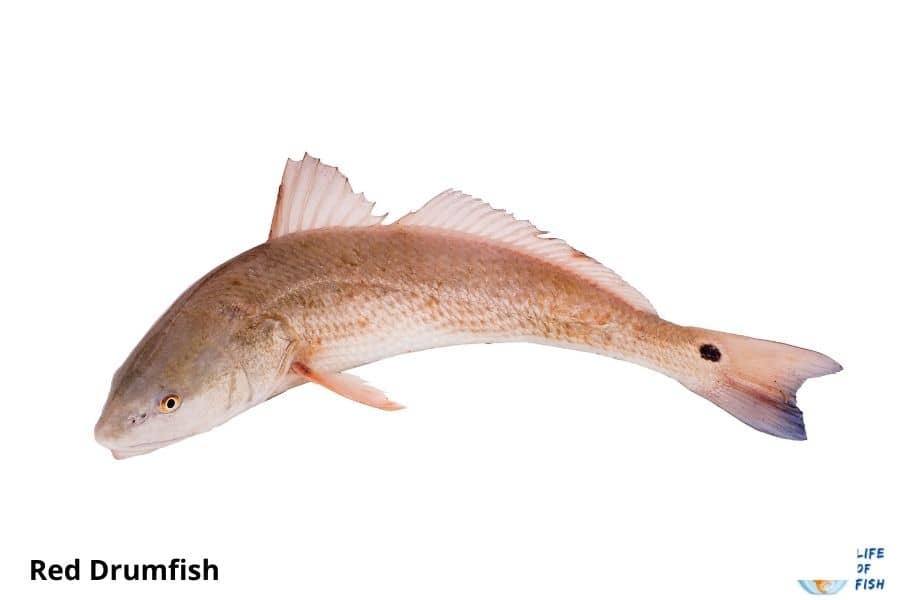
Best Place To Fish for Red DrumFish
Adult reds can get found in waters with a concentration of more than 15 parts per thousand from April to November.
A lucky angler may locate them from the Patuxent River to the Virginia/Maryland line in the Middle Bay.
For many anglers, red drum fishing is a favorite pastime, particularly near the Bay’s shoals. The Chesapeake Bay is home to many juvenile redfish and giant bull redfish throughout the year.
How to Catch Red DrumFish?
Redfish often get caught in baits along the Chesapeake Bay coast and the Mid-Atlantic coastline, especially at night or while surfing.
The most common options include Peeler or softer crabs / Menhadens/Mullets/Shrimp.
Redfish are still a popular target for anglers even though there are limited slots, and releasing a big fish is a must.
It is no surprise, considering how exciting it can be to catch one of these enormous fish.
Can you Eat Red DrumFish?
Redfish has a medium flaky texture and white flesh. The most delectable redfish are those that are less than 10 to 15 pounds.
If adequately prepared, it is safe to consume. Raw redfish meat does not get recommended due to the potential parasites.
Note: Drums may contain trematode ocean parasites. Thus they must get cooked to a temperature of 145°F on the inside
Black Drumfish (Salt Water Fish)
New England, Texas’ coast, and Mexico’s coast are all home to the black drum. They are most commonly captured in the mid-Atlantic, near Texas.
Juvenile and more minor black drummers will get found in brackish estuaries. In contrast, older black drums will be found in the Gulf of Mexico’s more expansive and saltier waters.
In big bays, enormous black drum schools can get discovered.
Their 113-pound weight set a new world record. The black drum’s primary food source is crustaceans.
Smaller drums are more pleasurable to eat, but more giant drums are more likely to get wormy. The “inferior” mouth of a black drum is behind its nose.
Drums have crushers in their throats, allowing them to eat anything that has a shell.
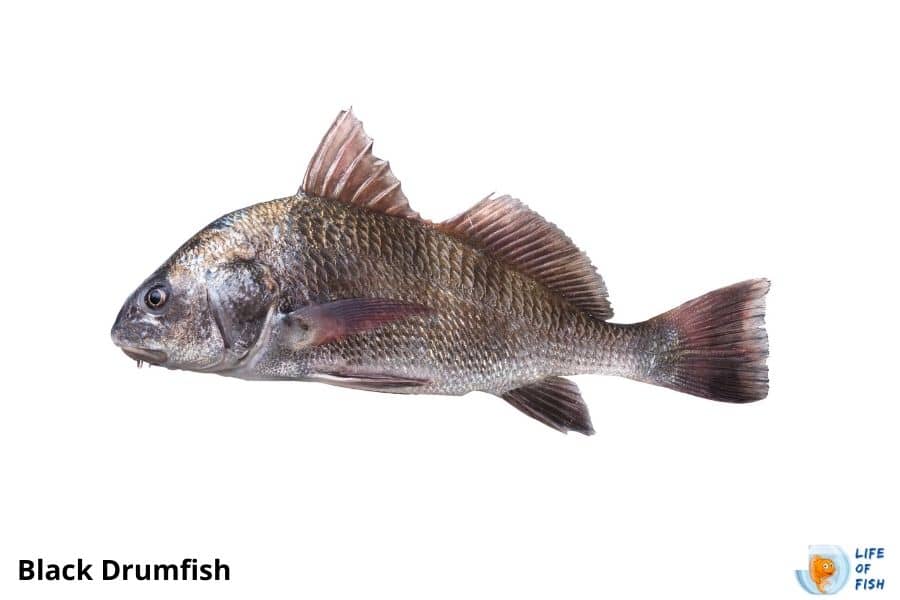
Best Place To Fish for Black Drumfish
Fishers can encounter black drummers on bridges and docks because they provide structure, shade, and forage.
They get frequently found in places with significant current flow. Docks and bridges are ideal places for black drum fishing because these factors also give anglers who don’t have access to a fishing boat.
How to Catch Black Drumfish?
Black drums eat mainly crustaceans, as mentioned earlier. All types of crabs are excellent fishing baits for black drums.
Blue crabs can be cut in quarters or halves, while smaller crabs can be fished whole. As with most saltwater species, shrimp are also a favorite forage for black drum.
The scent of shrimp and crabs is essential in attracting fish, both alive and dead; Both work well.
If there’s one piece of advice for anglers targeting black drum, it’s to keep the bait steady and on the bottom. It is valid for anglers who fish in both shallow and deep water.
In pursuit of food, black drums move around a lot. The bait’s smell and movement will attract a black drum.
Can you eat Black Drum?
Black drums are a delicacy to consume. All crustaceans, including black drums, are highly sought after. It only applies to smaller fish.
The optimum size for a black drum is 14″-24″. Because more giant drums are more prone to get wormy, releasing the breeding fish is preferable to keep the population healthy.
Freshwater Drumfish
Although freshwater drums prefer clear water, they can survive muddy or turbid environments. Freshwater drums are one of the most widely distributed animal species in North America.

Best Place To Fish for Freshwater Drum
Sheepshead and Gaspergou are other names for freshwater drum (Aplodinotus grunniens). It is also frequently found in the same waterways as walleye.
Despite its lack of popularity as a recreational fish, this drum has a sizable commercial market.
Freshwater drum fishing is possible all year. While freshwater drum numbers peak in the summer, they may get caught in the fall and winter if you can coax them out of hiding.
Unlike many other sportfish, which like to school in the deepest parts of rivers for a winter rest, freshwater drums may be coaxed from the water’s edge on the warmest and coldest days.
How To Catch Freshwater Drum
Freshwater drums are bottom feeders who eat mollusks, insects, and small fish. Despite being a formidable fighter, it does not get widely recognized as a sport or food fish.
The fishing methods used to catch this fish are as follows: where to catch this fish. You can either drift or still fish to catch the freshwater drum.
Fascinating Facts about Freshwater Drum
- Native Americans used the huge otoliths of freshwater drums to make bracelets and necklaces. Otoliths are found in the inner ear of all vertebrates, although they can only reach one inch in size for freshwater drums. The otolith helps fish keep balanced and orientated in unclean environments.
- The male freshwater drum makes its unique sound by vibrating its muscles the same way a cell phone does.
- According to some research, this fish may be learning how to consume zebra mussels because of its big molar-like crushing teeth.
- Freshwater drums’ eggs float on the water’s surface until they hatch. Before reaching their destination, the small fry (newly born fish) can travel kilometres along rivers and windswept lakes.
Can you Eat Freshwater Drum ?
Your well-earned evening meal may wonderfully finish off a full day of fishing if you prepare and eat your freshwater drum.
The flavor of the freshwater drum is comparable to that of redfish.
Bonus tip: You may fillet your catch to remove the bones, and it has a solid, not flaky feel when cooked. Freshwater drum gets cooked in various ways, including baking, broiled, fried, grilled, and smoked.
Totuava ( Fishing is illegal)
The totoaba (Totuava) is a big fish that lives in Mexico’s Gulf of California. It, like the vaquita, is listed as “critically endangered” by the IUCN Red List of Threatened Species.
The swim bladder of the totoaba gets prized in China, where it gets regarded as a delicacy.
The dried totoaba swim bladders are so expensive that they’re known as the “cocaine of the sea,” fetching up to $46,000 a kilogram on the illicit market in China.
Since 1975, totoaba fishing has been outlawed in Mexico.
The totoaba is the most notable species in the drum family, growing up to 2 m in length and 100 kg in weight.
Finned fish and crustaceans make up the totoabas’ diet. Individuals can live up to 15 years, although sexual maturity does not generally occur until the fish reach 6–7 years.
Because totoabas only spawn once a year, population growth is sluggish, taking anywhere from 4.5 to 15 years to double.
The Chinese trade in totoaba swim bladders has been a primary reason for its decline. Despite being illegal, this trade often happened quite openly.
Traders reported being warned before checks by Chinese authorities, allowing them to hide the swim bladders.
Both Mexican and Chinese authorities have tightened checks and performed raids, resulting in large confiscations and several arrests.
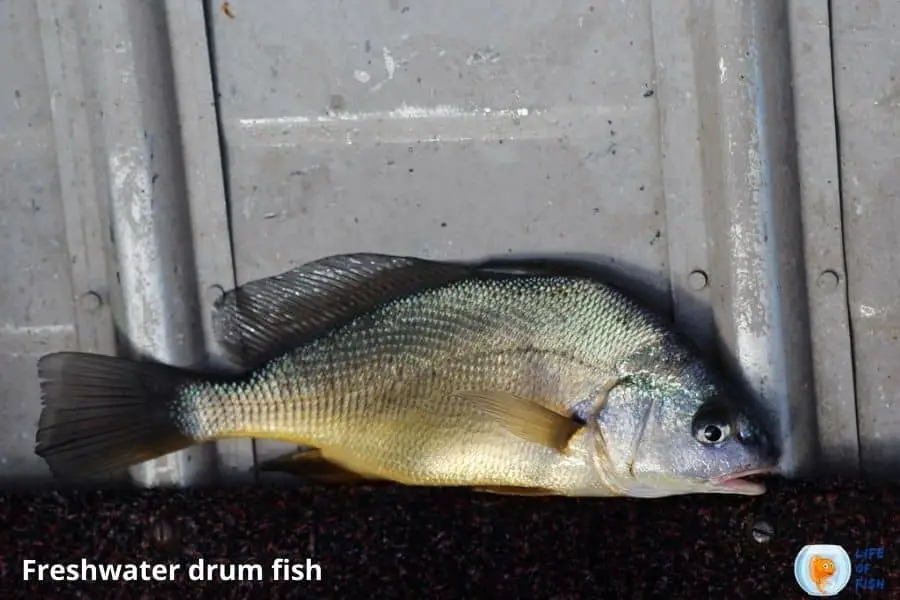
Conclusion
Drumfish often get caught for commercial and recreational uses. Commercial fishers use a net to acquire vast amounts of fish in more open waters. It was the world’s 25th most captured fish, according to United Nations data.
Drumfish flesh gets characterized as having a gentle, delicate, and somewhat sweet flavor.
Freshwater animals are captured and consumed considerably less frequently than saltwater ones. The angler has to know about their spawning environment and reproductive habits to catch a drum fish.
Many fish enthusiasts claim that freshwater drum fish has a poor flavor. Although both black and red drums can get used interchangeably, the black drum is meatier and can withstand nearly any cooking method.
These delicate flavors pair nicely with various spices, herbs, and vegetables, and the meat may get roasted, boiled, or sautéed.
Read Next: 9 Super Interesting Facts You Need To Know About Buffalo Fish
